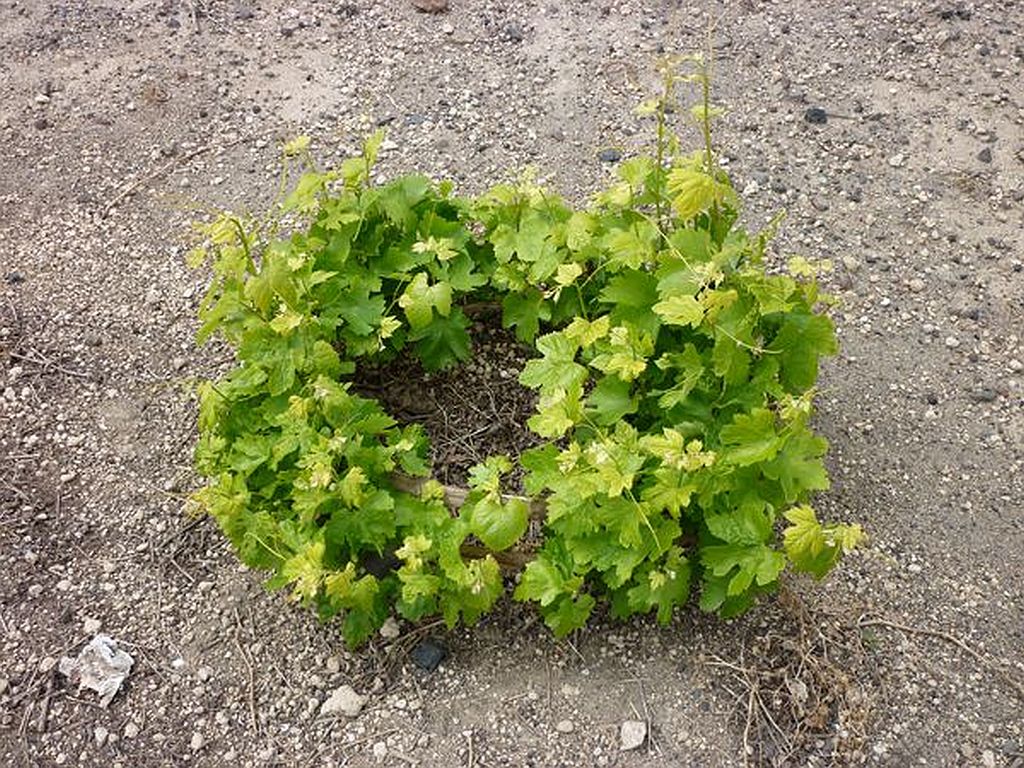Santorini’s “Kouloura” grapevine
Before you get the tasty 2014 Moschofilero into your mouth, you have to get Ktima Tseleops out of your mouth. Pronounced Ka-tee-ma, meaning estate, the Tselepos (Ts-el-e-pos) winery was founded by Yiannis Tselepos in 1989 in Peloponnese, a peninsula in southern Greece.
In 1978, after graduating from the highly regarded enology program at France’s University of Dijon, Tselepos worked two years in Burgundy. His return to Greece coincided with an interest in its indigenous grapes that led him to become known as the “Father of Moschofilero.” Tselepos said the grape gained its name from its grey skin color: In Greek, moscho means smoke.
Recently, Tselepos presented the 2014 Ktima Tselepos Mantinia Classic, a 100 percent moschofilero white wine at Betony, a one-star Michelin Guide restaurant in Manhattan. Its slight golden tint and suggested honey scent were followed by a clean, fresh lemon taste that was ideal with Betony’s fluke carpaccio. 88 Points. Retail is about $18.
Yiannis Tselepos with his Santorini wine at Betony.
Over the last decade or so, I’ve developed a deep appreciation for the vibrant citrus character of assyrtiko (A-seer-tee-ko) wine from Santorini. And it was renewed with a trip to the rocky, volcanic island two years ago.
Tselepos partnered with the local Chryossou family to develop their 25-acre vineyard with 50-to 100-year-old vines. The vines are farmed in Santorini’s traditional ground-hugging wreath, called “kouloura,” that protects the grapes from the island’s scorching summer sun and forceful winds.
The 2015 Ktima Tselepos Canava Chryossou Santorini delivered the sea breeze and lemon scent that I find enchanting. Across my palate rode a stream of thyme and lemon-y flavor underlined by a minerality from the volcanic soil in which the assyrtiko grapevines grow. 89 Points. Retail is about $33.
Betony’s chef, Bryce Shuman, seasoned his poached sea bass with lemon and thyme, showing he understood the 2015 Tselepos Canava Chryossou Santorini’s profile, too. It did what great cooking and wine pairing is supposed to do: make the sum better than the parts.
Ktima Biblia Chora (Bib-lee-ah Ho-ra) was created in 2001 by two respected Greek winemakers Vassilis Tsaktsartis and Vangelis Gerovassiliou in Kavala, East Macedonia.
The winery’s location at the base of the Pangeon mountains, whose gold and silver deposits were exploited by Alexander the Great, is where the Phoenicians cultivated a grape they called Biblos in rocky soil with a southern exposure, warm days and nightly cooling Aegean Sea breeze. From it, they produced the ancient wine Biblino Oeno.
Earlier this year, Ktima Biblia Chora’s export manager Annegret Stamos presented a selection of wines at New York City’s Kat & Theo restaurant.
Stamos began the tasting with a comparison of the 2008 and 2014 Ktima Biblia Chora Areti White wines. Both pure assyrtiko, the older wine’s acidity had mellowed while it retained its lemon accent. But the glass of the 2014 Areti White released assyrtiko’s energetic citrus character, sliding under the sweet scallop and green apple creation that announced the wine and the Kat & Theo’s chef were in sync. 90 Points. Retail is about $25.
Annegret Stamos with her Areti White wine.
Winemaker Vassilis Tsaktsarlis applied his University of Bordeaux oenology education with the blending of equal parts semillon and assyrtiko in the oak barrel-aged 2014 Ktima Biblia Chora Ovilos White. In Bordeaux, the classic blend of semillon and sauvignon blanc combines sauvignon blanc’s striking acidity with semillon’s gentleness.
This Greek intertwining of semillon and assyrtiko in the 2014 Ovilos White delivered a tropical fruit scent and surprising lime and pineapple flavors. Its fresh citrus character flattered the grilled octopus on its gigante bean puree bed and orange and oregano escorts. 90 Points. Retail is about $35.
Changing colors and linking history, the pure cabernet sauvignon 2010 Ktima Biblia Chora Biblinos Oenos arrived with its blackberry hue and Phoenician legacy. Cabernet sauvignon was unknown to the Phoenicians, but as voyagers, they would have loved the tingling black pepper and black fruit aromas that brought to mind California’s petit sirah. The black cherry and pomegranate flavors riding on tannins would have detoured them to South Africa’s pinotage before 20 minutes of aeration turned the compass towards Languedoc’s syrah. It was a striking journey of flavors for this wine, which ended in a safe port with the flatiron steak and onion confiture. 91 Points. Retail is about $49.
Ktima Biblia Chora Biblinos Oenos
I suspect that one impediment to Greek wines being widely known is the difficulty in pronouncing the names—a barrier for German wines, too. But it is a low hurdle for the pleasures found in the well-made wines of Ktimas Tselepos and Biblia Chora. And, All About Greek Wine has a handy audio pronunciation guide on its site: http://www.allaboutgreekwine.com/varieties.htm So, start listening and drinking!
Photos: John Foy












This article is really cool. I have bookmarked it.